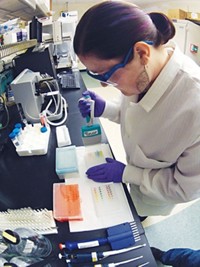Advertisement
Grab your lab coat. Let's get started
Welcome!
Welcome!
Create an account below to get 6 C&EN articles per month, receive newsletters and more - all free.
It seems this is your first time logging in online. Please enter the following information to continue.
As an ACS member you automatically get access to this site. All we need is few more details to create your reading experience.
Not you? Sign in with a different account.
Not you? Sign in with a different account.
ERROR 1
ERROR 1
ERROR 2
ERROR 2
ERROR 2
ERROR 2
ERROR 2
Password and Confirm password must match.
If you have an ACS member number, please enter it here so we can link this account to your membership. (optional)
ERROR 2
ACS values your privacy. By submitting your information, you are gaining access to C&EN and subscribing to our weekly newsletter. We use the information you provide to make your reading experience better, and we will never sell your data to third party members.
Biological Chemistry
Transforming Toxicology
Consortium works to accelerate development of 21st-century toxicology
by Celia Henry Arnaud
December 20, 2010
| A version of this story appeared in
Volume 88, Issue 51

Three years ago, the National Research Council released the report “Toxicity Testing in the 21st Century,” calling for the development of new approaches to human health risk assessment that would rely on in vitro assays and computer-based models instead of animal testing.
Although the scientific community has embraced the NRC vision, many scientists worry that the transition will be too slow. The Human Toxicology Project Consortium—a coalition of corporations, the Hamner Institutes for Health Sciences, and the Humane Society of the U.S.—convened a meeting last month to take a snapshot of the current scientific landscape and discuss how to accelerate the transformation of toxicology into a science that is both predictive and compassionate.
But before scientists can understand how a chemical will behave in a living system simply by running it through a panel of cell-based screening assays or plugging it into a computational model, they need a clear understanding of the cellular pathways that are involved in toxicity and the responses that are indicative of adverse outcomes. At last month’s meeting, participants learned about a number of ongoing initiatives, in the U.S. and around the world, to identify those pathways and use them to develop new approaches to toxicology.
For example, in the U.S., several government agencies, including the National Institutes of Health, the Environmental Protection Agency, and the Food & Drug Administration, are collaborating on a project called Tox21 to “research, develop, validate, and translate innovative chemical testing methods that characterize toxicity pathways,” said Raymond Tice, chief of the biomolecular screening branch at the National Toxicology Program at the National Institute of Environmental Health Sciences.
A significant contribution to the Tox21 effort comes from ToxCast, an EPA program that builds predictive toxicology models with data from high-throughput screening assays, said Robert J. Kavlock, director of EPA’s National Center for Computational Toxicology. In the first phase of the program, more than 300 compounds, mostly pesticides, were analyzed. The second phase is currently under way, with the goal of analyzing an additional 700 compounds, including failed drugs donated by pharmaceutical companies, Kavlock said.
Whereas U.S. efforts are science-driven, the search for alternative methods of toxicity testing is policy-driven in the European Union, said Horst Spielmann, a professor of regulatory toxicology at Free University of Berlin and retired head of the National German Center for the Documentation & Evaluation of Alternatives to Testing in Animals at the Federal Institute for Risk Assessment. REACH (Registration, Evaluation, Authorization & Restriction of Chemical substances) is a European Commission law that requires industry to provide safety information about chemicals (C&EN, Nov. 29, page 15), and under the Cosmetics Directive, another European law, the cosmetics industry must eliminate the use of animals in toxicity testing by 2013.
The EC’s Joint Research Centre in Ispra, Italy, is providing scientific support to help implement those policies, said Maurice Whelan, head of the systems toxicology unit of the Institute for Health & Consumer Protection at JRC. Whelan’s team is selecting appropriate chemicals, assays, and cell systems to build and evaluate in vitro models of toxicity. For example, the group is culturing neurons on microchips to monitor neuronal electrophysiology as a type of in vitro EEG, a medical test of brain electrical activity. The reliability of this neurotoxicity test system was demonstrated recently in a round-robin trial involving six labs in Europe and the U.S.
Several European nongovernmental programs are also helping steer the development of new approaches to toxicology. AXLR8, an EU project coordinated by Spielmann, seeks to accelerate the transition to a toxicity-pathway-based paradigm for chemical safety assessment by providing a forum for networking, information exchange, and collaboration, Spielmann said. The Transatlantic Think Tank of Toxicology is an effort—shared among the Center for Alternatives to Animal Testing (CAAT) at Johns Hopkins University; the University of Konstanz, in Germany; and Utrecht University, in the Netherlands—that seeks to advance evidence-based toxicology, said Thomas Hartung, director of CAAT.

Much of the focus has been on identifying chemicals that pose hazards to human health, but risk assessment requires exposure information as well. The Risk Assessment in the 21st Century Project (Risk21)—sponsored by the ILSI Health & Environmental Sciences Institute, part of the International Life Sciences Institute—is trying to look at the whole picture. In Risk21, approximately 90 scientists from industry, academia, government, and nongovernmental organizations participate on four project teams that are focusing on ways to characterize real-world chemical exposure, incorporate dose-response information into risk assessment, develop a framework for toxicity testing, and account for the cumulative risk of exposure to multiple agents, said Timothy P. Pastoor, a toxicologist at Syngenta who is cochair of Risk21.
In addition to projects undertaken by government and nongovernmental organizations, companies are launching programs to advance predictive toxicology. For example, U.K.-based Unilever’s skin sensitization program is developing in vitro and computational methods to assess the risk of contact dermatitis, said Cameron MacKay, a mathematical modeler in the toxicology modeling group at Unilever’s Safety & Environmental Assurance Centre. To do this, MacKay and his colleagues are working to understand the biology of allergic responses in human skin and incorporating what they learn into computational models of the process.
With so many different projects contributing to the implementation of the NRC vision for 21st-century toxicity testing, there’s a need to coordinate the various efforts, said Martin Stephens, vice president for animal research issues at the Humane Society. The Human Toxicology Project Consortium is calling for an international large-scale program analogous to the Human Genome Project that can “get us to the finish line sooner rather than later,” Stephens said. Such a “human toxicology project” would underscore a sense of mission and urgency, he said. It is especially important that any data be publicly available.
The many projects already under way are potential partners for such an endeavor, said Andrew N. Rowan, chief scientific officer at the Humane Society. Each individual project may be small, but collectively more than $200 million annually is already being spent on the various programs, Rowan said. Thus, resources are not the issue. What is needed is coordination.
Part of the consortium’s work is in developing a pilot project to gauge the effectiveness of pathway-based approaches to toxicity testing, said Melvin E. Andersen, director of the Program in Chemical Safety Sciences at the Hamner Institutes. For this project, consortium members are selecting a group of no more than 10 well-studied compounds and pathways, which they incorporate into assays using human or rodent cells or tissue surrogates. They will then use the results from those assays to refine quantitative risk assessment.
George P. Daston, a toxicologist at Procter & Gamble, worries that a headlong rush to find a replacement for the current toxicology paradigm will simply replace an existing “one size fits all” system of default methods with another. People don’t yet know what will work, he said. He urges the community not to be too hasty in trying to nail down a particular set of pathways and assays. “All these approaches need to be integrated,” he said.
Such caution notwithstanding, meeting participants were optimistic about the prospects for modernizing toxicology. “The paradigm shift in toxicology that is about to happen is a once-in-a-lifetime opportunity,” Hartung said. Paraphrasing Victor Hugo, Hartung noted that “nothing is as strong as an idea whose time has come.”




Join the conversation
Contact the reporter
Submit a Letter to the Editor for publication
Engage with us on Twitter